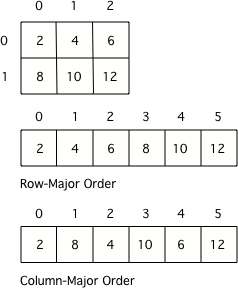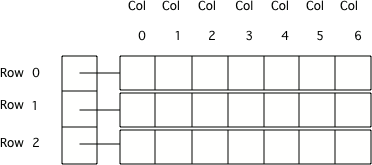Section 4.11 2D Array Creation and Access
90 minutes
Arrays in Java can store many items of the same type. You can even store items in two-dimensional (2D) arrays which are arrays that have both rows and columns. A row has horizontal elements. A column has vertical elements. In the picture below there are 3 rows of lockers and 6 columns.

Two dimensional arrays are especially useful when the data is naturally organized in rows and columns like in a spreadsheet, bingo, battleship, theater seats, classroom seats, or a picture. In battleship, letters map to the rows (A is the first row, B is the second row, and so on) and the column indices start with 1.
A 2D array is stored as an array of arrays in Java. The way 2D arrays are created and indexed is similar to 1D array objects. The size of a 2D array is established at the time of creation and cannot be changed. 2D arrays can store either primitive data or object reference data.
Subsection 4.11.1 Array Storage
Many programming languages actually store two-dimensional array data in a one-dimensional array. The typical way to do this is to store all the data for the first row followed by all the data for the second row and so on. This is called row-major order. Some languages store all the data for the first column followed by all the data for the second column and so on. This called column-major order.

Java actually stores a two-dimensional array as an array of arrays. Each element of the outer array has a reference to each inner array. The picture below shows a 2D array that has 3 rows and 7 columns. Notice that the array indices start at 0 and end at the length - 1.

On the exam assume that any 2 dimensional (2D) array is in row-major order. The outer array can be thought of as the rows and the inner arrays the columns. On the exam all inner arrays will have the same length even though it is possible in Java to have inner arrays of different lengths (also called non-rectangular arrays or ragged arrays).
Try to answer the following questions. Click on the value or values to select them. Click again to unselect a value.
Activity 4.11.1.
Activity 4.11.2.
Activity 4.11.3.
Activity 4.11.4.
Activity 4.11.5.
Subsection 4.11.2 Declaring 2D Arrays
2D arrays are declared and created with the following syntax, which is very similar to 1D arrays but include 2 dimensions (
[][]). The code below creates a 2D array with 2 rows and 3 columns named ticketInfo and a 2D array with 3 rows and 2 columns named seatingChart. The number of elements in a 2D array is the number of rows times the number of columns.
// 2D array declaration
// datatype[][] variableName = new datatype[numberRows][numberCols];
int[][] ticketInfo = new int[2][3];
String[][] seatingChart = new String[3][2];
Arrays are objects in Java, so any variable that declares an array holds a reference to an object. If the array hasn’t been created with new yet and you try to print the value of the variable, it will print null (meaning it doesn’t reference any object yet). When a 2D array is created using the keyword
new, all of its elements are initialized to the default values for the element data type. The default value for int is 0, for double is 0.0, for boolean is false, and for a reference type is null.
Activity 4.11.6.
Activity 4.11.7.
What will the following code print out? Can you change ticketInfo to be an array of 5 rows and 10 columns? Can you declare another array called studentNames that has 10 rows and 5 columns? The length property of arrays will be explained below.
Subsection 4.11.3 Initializer Lists for 2D Arrays
You can also initialize (set) the values for the array when you create it. In this case you don’t need to specify the size of the array, it will be determined from the values you give. The code below creates an array called
ticketInfo with 2 rows and 3 columns. It also creates an array called seatingInfo with 3 rows and 2 columns. Note that the initializer list used to create and initialize a 2D array consists of 2 initializer lists that represent 1D arrays for each row.
int[][] ticketInfo = { {25,20,25}, {25,20,25} };
String[][] seatingInfo = { {"Jamal", "Maria"}, {"Jake", "Suzy"}, {"Emma", "Luke"} };
Activity 4.11.8.
Subsection 4.11.4 Set Values in a 2D Array
The square brackets
[row][col] are used to access and modify an element in a 2D array. When accessing the element at arr[first][second], the first index is used for rows, the second index is used for columns. To explicitly put a value in an array, you can use assignment statements with the name of the array followed by the row index in square brackets followed by the column index in square brackets and then an = followed by a value.
int[][] ticketInfo = new int[2][3];
ticketInfo[0][0] = 15;
Try the code below. Did it print what you expected? When you print a two dimensional array you just get the reference to the object. In the next lesson, we’ll learn how to use nested loops to print out the whole 2D Array. Right now, use the CodeLens button or the Java Visualizer to see what the values are after this code runs. Edit the code to add in an extra row to the
1
http://cscircles.cemc.uwaterloo.ca/java_visualize/#code=public+class+Test+%0A++%7B%0A+++++public+static+void+main(String%5B%5D+args)%0A+++++%7B%0A++++++++//+declare+arrays%0A++++++++int%5B%5D%5B%5D+ticketInfo%3B%0A++++++++String%5B%5D%5B%5D+seatingChart%3B%0A++++++++%0A++++++++//+create+arrays%0A++++++++ticketInfo+%3D+new+int+%5B2%5D%5B3%5D%3B%0A++++++++seatingChart+%3D++new+String+%5B3%5D%5B2%5D%3B%0A++++++++%0A++++++++//+initialize+the+array+elements%0A++++++++ticketInfo%5B0%5D%5B0%5D+%3D+15%3B%0A++++++++ticketInfo%5B0%5D%5B1%5D+%3D+10%3B%0A++++++++ticketInfo%5B0%5D%5B2%5D+%3D+15%3B%0A++++++++ticketInfo%5B1%5D%5B0%5D+%3D+25%3B%0A++++++++ticketInfo%5B1%5D%5B1%5D+%3D+20%3B%0A++++++++ticketInfo%5B1%5D%5B2%5D+%3D+25%3B%0A++++++++seatingChart%5B0%5D%5B0%5D+%3D+%22Jamal%22%3B%0A++++++++seatingChart%5B0%5D%5B1%5D+%3D+%22Maria%22%3B%0A++++++++seatingChart%5B1%5D%5B0%5D+%3D+%22Jacob%22%3B%0A++++++++seatingChart%5B1%5D%5B1%5D+%3D+%22Suzy%22%3B%0A++++++++seatingChart%5B2%5D%5B0%5D+%3D+%22Emma%22%3B%0A++++++++seatingChart%5B2%5D%5B1%5D+%3D+%22Luke%22%3B%0A++++++++%0A++++++++//+print+the+contents%0A++++++++System.out.println(ticketInfo)%3B%0A++++++++System.out.println(seatingChart)%3B%0A+++++%7D%0A++%7D&mode=display&curInstr=0seatingChart and add your name and a friend’s name in the columns of this extra row using assignment statements.
Activity 4.11.9.
Add another row of data to the arrays by changing the size of the arrays and adding in the assignment statements for the cells in those rows.
Activity 4.11.10.
Which of the following sets the value for the 3rd row and 2nd column of a 2D array called
nums?
- nums[3][2] = 5;
- Remember that the indices start at 0.
- nums[1][2] = 5;
- Remember that the row is first then the column.
- nums[2][1] = 5;
- This will set the value of the 3rd row and 2nd column.
- nums[2][3] = 5;
- Remember that the row is first and then the column and that the indices start at 0.
Subsection 4.11.5 Get a Value from a 2D Array
To get the value in a 2D array give the name of the array followed by the row and column indices in square brackets. The code below will get the value at row index 1 and column index 0 from
ticketInfo. It will also get the value at row index 0 and column index 1 from seatingChart.
int[][] ticketInfo = { {25,20,25}, {25,20,25} };
String[][] seatingInfo = { {"Jamal", "Maria"}, {"Jake", "Suzy"}, {"Emma", "Luke"} };
int value = ticketInfo[1][0];
String name = seatingInfo[0][1];
Activity 4.11.11.
What is the value of
name after the code above executes?
- Jamal
- This would be true for if name was set to seatingInfo[0][0]; instead.
- Maria
- Maria is the value of seatingInfo[0][1];.
- Jake
- This would be true for if name was set to seatingInfo[1][0]; instead.
- Suzy
- This would be true for if name was set to seatingInfo[1][1]; instead.
- Emma
- This would be true for if name was set to seatingInfo[2][1]; instead.
Activity 4.11.12.
Add another row to seatingInfo initialized to your name and a friend’s name. Get these names out of the array using the correct indices and then print them out.
Subsection 4.11.6 2D Array Row and Column length
Arrays know their length (how many elements they can store). The length is a public read-only attribute for array objects. The number of rows contained in a 2D array can be accessed through the array name and the
length attribute: arrayName.length. The number of columns contained in a 2D array can be accessed through the length attribute of one of the rows, for example arrayName[0].length, which gives a single array that is a row of a 2D array using the 2D array name and a single set of square brackets containing the row index.
ticketInfo.length // returns the number of rows
ticketInfo[0].length // returns the number of columns
Note 4.11.9.
Note that length is an attribute and not a method, so you don’t add parentheses after length. However, if you use parentheses after length during the exam, you won’t lose any points. Since for the AP CSA exam all two-dimensional arrays are rectangular arrays (arrays that have the same number of columns in each row) you can just use the length of the first inner array as the number of columns as shown by
ticketInfo[0].length.
The valid row index values for a 2D array are
0 through one less than the number of rows or the length of the array, inclusive. The valid column index values for a 2D array are 0 through one less than the number of columns or the length of any given row of the array, inclusive. For example, given a 2D array named values, the number of rows is values.length and the number of columns is values[0].length`. Using an index value outside of these ranges will result in an ArrayIndexOutOfBoundsException.
Activity 4.11.13.
Activity 4.11.14.
Which of the following could be used to get the value in the third row and second column from a 2D array called
nums?
- nums[3][2]
- This would be true if array indices started with 1 but they start with 0.
- nums[2][3]
- This would be true if array indices started with 1 and the column was specified first. However, array indices start at 0 and the row is given first in row-major order.
- nums[2][1]
- Array indices start with 0 so the third row has an index of 2 and the second column has an index of 1.
- nums[1][2]
- This would be true if the column index was first, but in row-major order the row index is first.
Subsection 4.11.7 Coding Challenge : ASCII Art
ASCII is a commonly used character encoding standard where each key you press on the keyboard is translated to an ASCII number to be stored in the computer. ASCII has been mostly replaced by UNICODE which includes characters in other languages like Chinese. In the days before good graphics, some people made ASCII art just using the keyboard characters. Take a look at this ASCII art collection!
2
https://www.asciiart.eu/We can represent ASCII art in a 2D array of rows and columns. What do you think the following code will print out? Try to guess before you run it. The loops to print out the 2D array will be explained in the next lesson. Then, do the following:
-
Change the code to use 2 assignment statements with the 2D array
asciiArtto change the “o” characters to “@” characters. You should figure out what the row and column indices should be for the “o” characters and use them with the array name to set that character to “@”. After testing this code, comment it out so that your teacher can still see it. -
Add a new
asciiArtarray with a different ASCII artfrom the collection or of your own design. Be careful with the special characters like3
https://www.asciiart.eu/"and\. You will need to put another backslash in front of these to print them out like\"and\\.
Project 4.11.15.
Part 1: Add 2 assignment statements for the 2D array asciiArt to change the “o” characters to “@” characters. Part 2: Create a new asciiArt array and print it out.
Subsection 4.11.8 Summary
-
(AP 4.11.A.1) A 2D array is stored as an array of arrays. Therefore, the way 2D arrays are created and indexed is similar to 1D array objects. The size of a 2D array is established at the time of creation and cannot be changed. 2D arrays can store either primitive data or object reference data. Nonrectangular 2D array objects (with varying column length for each row) are outside the scope of the AP Computer Science A course and exam.
-
2D arrays are declared and created with the following syntax:
datatype[][] variableName = new datatype[numberRows][numberCols]; -
(AP 4.11.A.2) When a 2D array is created using the keyword
new, all of its elements are initialized to the default values for the element data type. The default value forintis0, fordoubleis0.0, forbooleanisfalse, and for a reference type isnull. -
(AP 4.11.A.3) The initializer list used to create and initialize a 2D array consists of initializer lists that represent 1D arrays; for example,
int[][] arr2D = { {1, 2, 3}, {4, 5, 6} };. -
(AP 4.11.A.4) The square brackets
[row][col]are used to access and modify an element in a 2D array. For the purposes of the AP exam, when accessing the element atarr[first][second], thefirstindex is used for rows, thesecondindex is used for columns. -
Row-major order refers to an ordering of 2D array elements where traversal occurs across each row, while column-major order traversal occurs down each column.
-
(AP 4.11.A.5) A single array that is a row of a 2D array can be accessed using the 2D array name and a single set of square brackets containing the row index.
-
(AP 4.11.A.6) The number of rows contained in a 2D array can be accessed through the
lengthattribute. The valid row index values for a 2D array are0through one less than the number of rows or the length of the array, inclusive. The number of columns contained in a 2D array can be accessed through thelengthattribute of one of the rows. The valid column index values for a 2D array are0through one less than the number of columns or the length of any given row of the array, inclusive. For example, given a 2D array namedvalues, the number of rows isvalues.lengthand the number of columns isvalues[0].length`. Using an index value outside of these ranges will result in anArrayIndexOutOfBoundsException.
Subsection 4.11.9 2D Arrays Game
Try the game below to practice 2D Arrays. Click on Arrays and then check on 2D and click on the elements of the * array that would be printed out by the given code. If you’re stuck, check on Labels to see the indices. We encourage you to work in pairs and see how high a score you can get.
You have attempted of activities on this page.

